Oilfield Communications Market Size
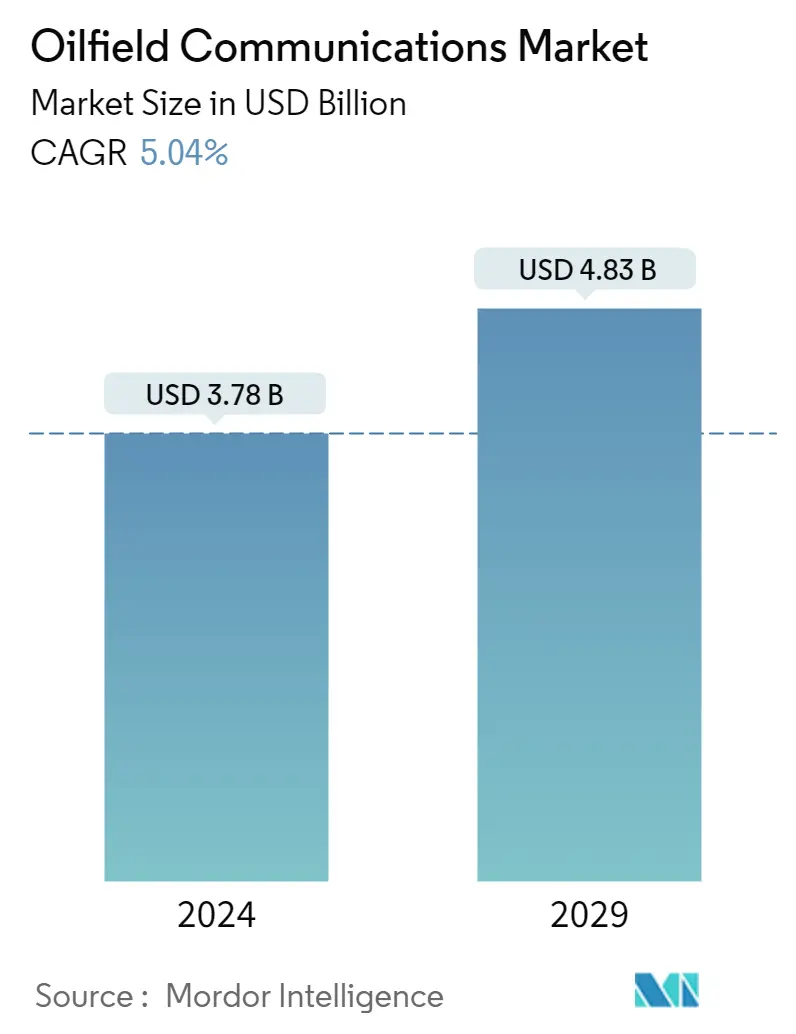
| Study Period | 2019 - 2029 |
| Market Size (2024) | USD 3.78 Billion |
| Market Size (2029) | USD 4.83 Billion |
| CAGR (2024 - 2029) | 5.04 % |
| Fastest Growing Market | Asia-Pacific |
| Largest Market | North America |
Major Players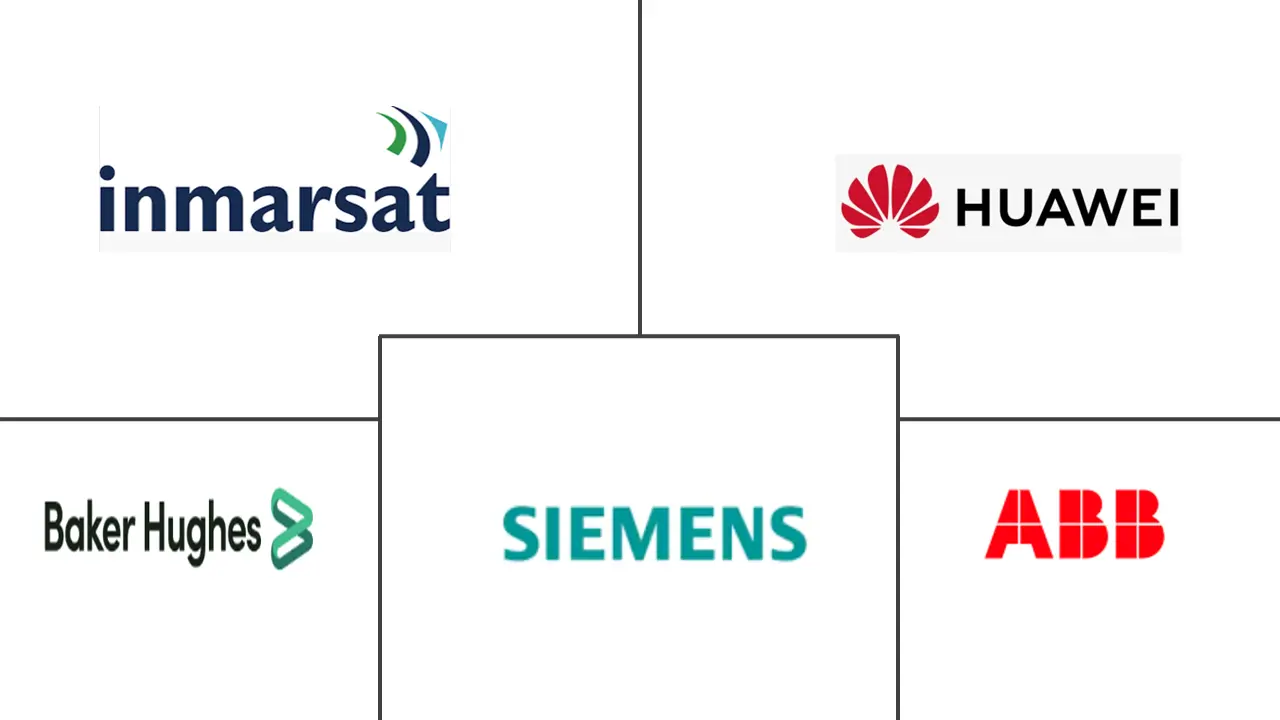
*Disclaimer: Major Players sorted in no particular order |
Oilfield Communications Market Analysis
The Oilfield Communications Market size is estimated at USD 3.78 billion in 2024, and is expected to reach USD 4.83 billion by 2029, growing at a CAGR of 5.04% during the forecast period (2024-2029).
The oilfield communication market is being driven by the exponential expansion and widespread acceptance of cutting-edge technologies like machine learning, artificial intelligence, cognitive intelligence, and cloud, owing to the rising investment in improving network infrastructure as dependable hardware is needed for mission-critical activities in the oilfields, which depend on consistent communication.
- Several nations, like the GCC, have significantly invested in upgrading their telecommunications infrastructure. Companies are quickly expanding the capabilities of business processes by fusing automation with cognitive and artificial intelligence (AI) technology. The infrastructure helps to improve staff welfare, resource management, network connectivity, and health and safety regulations.
- These advantages are driving up investments in network communication to support their ambitious digital transformation ambitions, which is driving up demand for oilfield communications products and has foreseen the industry's expansion.
- Additionally, the rising adoption of contemporary cloud-based technologies in the oil and gas industry propels market growth. These services provide better real-time data, more flexibility in infrastructure costs, and the capacity to scale data management and storage. Maintenance and monitoring of production units, wells, and oilfields are now appealing options made possible by cloud-based technologies, such as computing services. Businesses are transforming and relying on edge and cloud services to digitalize their assets, decentralize data processing, and deploy SaaS solutions for operations. With cutting-edge breakthrough technology, cloud solutions can transform and open up a wealth of novel and exciting oilfield options.
- A significant amount of cloud-based service capabilities are being used in the energy sector due to the high computing power made available by cloud platforms, which also encourages the adoption of other technologies like the intelligent management of physical assets and promotes greater operational efficiency. Therefore, the oil and gas industry's growing embrace of contemporary cloud-based technology is anticipated to drive the need for oilfield communications.
- Oil is a limited resource that has a little shelf life. Oil prices have also fluctuated throughout the years because of shifting supply and demand for oilfield communication and geopolitical events. Geoscientists are constantly working to find new oil sources and investigate undiscovered reserves. On the other hand, researchers are looking at non-traditional energy sources nonstop. At the coronavirus outbreak, the demand for oilfield communications and market future trends were waning. It will be disastrous for the market if the situation worsens for several years.
Oilfield Communications Market Trends
Growing Adoption of Cloud-based Services to Drive the Market Growth
- With the growing adoption of cloud-based services, oil companies are compelled to use oil field communication. This keeps their offshore sites connected with the inshore site about production stats, which helps in better supply chain management. The smooth flow of materials is very important for oil companies as their profitability is highly dependent upon the turnover, and downtime needs to be avoided.
- For instance, over the past two and a half years, GE Oil & Gas, the service provider to oil and gas companies, has shifted 350 of its applications to Amazon's cloud offering, AWS. GE found that the total cost of ownership of running its enterprise applications on the cloud systems provided a saving of 52% on average. This is the dominant trend in the sector's most progressive companies.
- According to Siemens AG, data-based solutions will lead to huge gains in terms of efficiency gains and cost savings. According to Siemens, digitization can reduce Brent price cost per barrel by 45% while reducing the upstream capital cost index and operations cost index by 25% and 18%, respectively.
- Cloud technology has effectively addressed security concerns that previously restrained its adoption, thereby rewarding pioneering companies with the transparency to revolutionize their outdated on-premise systems.
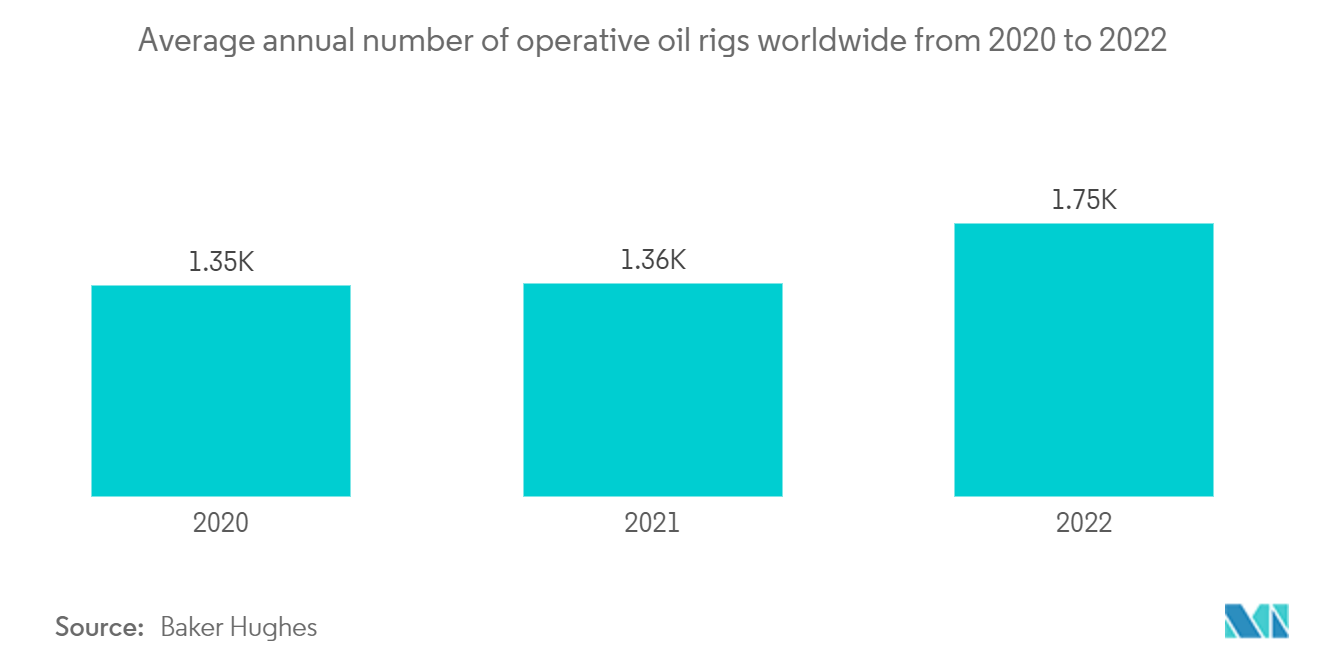
North America to Account for a Major Share
- North America is the pioneer in this market and is expected to hold a significant share as it is the largest oil and gas producer, with companies seeking advanced digital communication solutions for their onshore and offshore field operations.
- Many oil-producing companies are headquartered in the United States. Most companies pilot new services in the country before global launches and deployment.
- This country's fast adoption of new technology and the growing focus on global communication push the market forward.
- Moreover, with newfound shale resources and rapidly increasing exploration and production activities due to the Outer Continental Shelf Leasing Program approved by OCS, the region is expected to be one of the fastest-growing markets for oilfield communications over the forecast period.
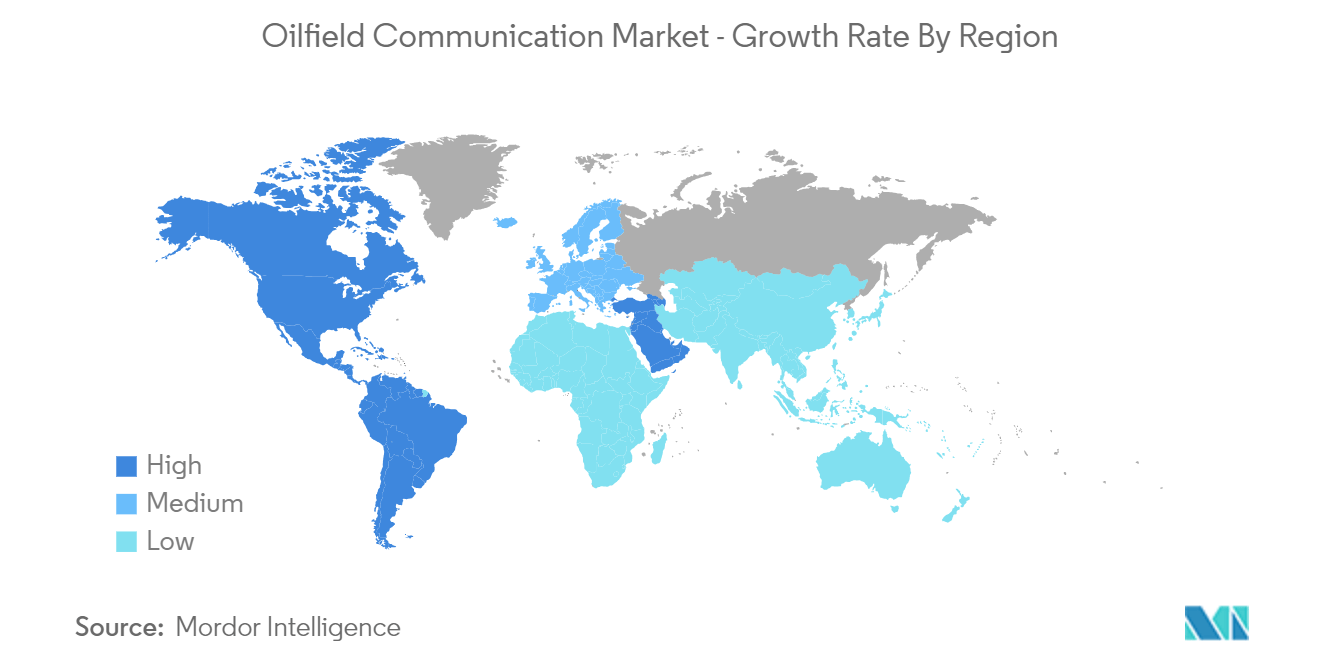
Oilfield Communications Industry Overview
The oilfield communications market has a few major players who provide the entire spectrum of solutions. The major players include Siemens AG, ABB Ltd, Huawei Technologies Co. Ltd, Baker Hughes (General Electric Company), Inmarsat PLC, and Speedcast International Limited. Merger and Acquisition are expected to be one of the key growth strategies of the market, which will change the dynamics of competition in this industry and increase opportunities for new product development.
In July 2022, Baker Hughes announced it would acquire AccessESP, one of the top cutting-edge technology suppliers for artificial lift solutions. Oil and gas operations might be modernized by cutting operational expenses and downtime and becoming considerably more productive.AccessESP's "GoRigless ESP System" offers its unique solutions that enable the installation and dismantling of an electrical submersible pump (ESP) using common, light-duty intervention tools instead of a rig or pulling well production tubings, such as a wireline, coiled tubing, or well tractors. The importance of ESP replacement workovers, which are becoming increasingly crucial in offshore and remote situations, is considerably reduced by these solutions in terms of cost and downtime.
In May 2022, to reduce total wellhead installation costs due to fewer rig visits, Baker Hughes, a US-based oilfield communications business, introduced a novel subsea wellhead technology called the MS-2 Annulus Seal. At the offshore technology conference in Houston in 2022, several clients in North and South America presented, displayed, and adopted this integrated sealing system.
Oilfield Communications Market Leaders
-
Siemens AG
-
ABB Ltd
-
Huawei Technologies Co. Ltd.
-
Baker Hughes (General Electric Company)
-
Inmarsat PLC (Triton Bidco)
*Disclaimer: Major Players sorted in no particular order
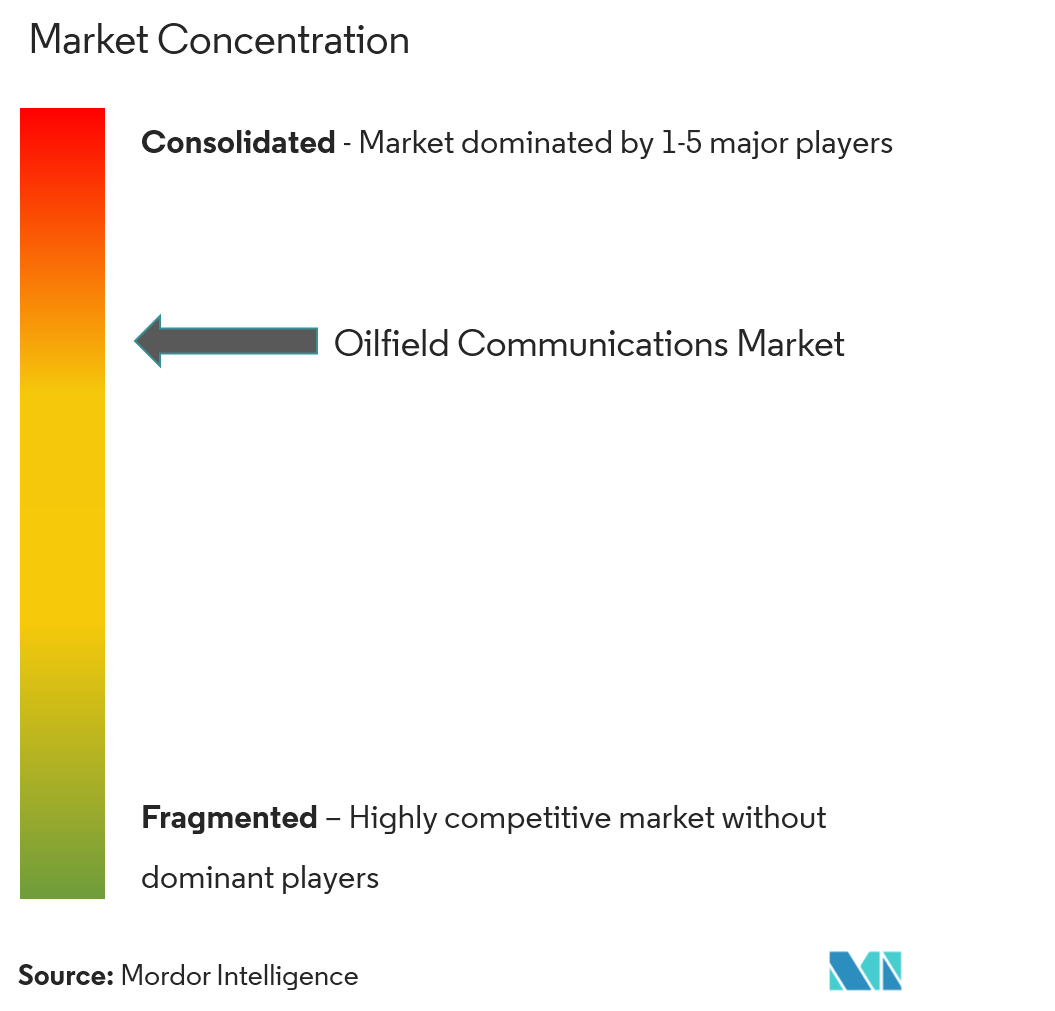
Oilfield Communications Market News
- December 2022: To undertake environmental evaluations for offshore wind and oil and gas developments, DeepOcean and Akvaplan-Niva cooperated on the potential usage of remotely operated vehicles (ROVs) and uncrewed glider vehicles (USVs).
- May 2022: To provide IoT connection management to the offshore business, Ericsson and Tampnet teamed together. Modern sensors and remote monitoring technology could be placed on people and objects in various remote offshore use cases and connected in real-time due to the management capabilities of the Ericsson IoT Accelerator.
Oilfield Communications Market Report - Table of Contents
1. INTRODUCTION
- 1.1 Study Assumptions and Definitions
- 1.2 Scope of the Study
2. RESEARCH METHODOLOGY
3. EXECUTIVE SUMMARY
4. MARKET INSIGHTS
- 4.1 Market Overview
-
4.2 Industry Attractiveness - Porter's Five Forces Analysis
- 4.2.1 Bargaining Power of Buyers/Consumers
- 4.2.2 Bargaining Power of Suppliers
- 4.2.3 Threat of New Entrants
- 4.2.4 Threat of Substitute Products
- 4.2.5 Intensity of Competitive Rivalry
- 4.3 Industry Value Chain Analysis
5. MARKET DYNAMICS
-
5.1 Market Drivers
- 5.1.1 Growing Adoption of Cloud-based Services
- 5.1.2 Geographically Challenging Locations will Increase Reliance on Digital Communication for Oilfield Recovery and Productivity
- 5.1.3 Development and Adoption of Effective Communication Technologies
-
5.2 Market Restraints
- 5.2.1 Stringent Regulatory Framework and the Rising Risk of Inadequate Data and Asset security
6. MARKET SEGMENTATION
-
6.1 By Solution
- 6.1.1 M2M Communication
- 6.1.2 Unified Communication Solutions
- 6.1.3 Video Conferencing
- 6.1.4 VoIP
- 6.1.5 Wired/Wireless Intercom
- 6.1.6 Other Solutions
-
6.2 By Communication Network
- 6.2.1 Cellular Communication Network
- 6.2.2 VSAT Communication Network
- 6.2.3 Fiber Optic-Based Communication Network
- 6.2.4 Microwave Communication Network
- 6.2.5 Tetra Network
-
6.3 By Field Site
- 6.3.1 Onshore Communications
- 6.3.2 Offshore Communications
-
6.4 Geography
- 6.4.1 North America
- 6.4.1.1 United States
- 6.4.1.2 Canada
- 6.4.2 Europe
- 6.4.2.1 United Kingdom
- 6.4.2.2 Germany
- 6.4.2.3 Rest of Europe
- 6.4.3 Asia-Pacific
- 6.4.3.1 China
- 6.4.3.2 Japan
- 6.4.3.3 Rest of Asia-Pacific
- 6.4.4 Latin America
- 6.4.4.1 Mexico
- 6.4.4.2 Brazil
- 6.4.4.3 Rest of Latin America
- 6.4.5 Middle East & Africa
- 6.4.5.1 United Arab Emirates
- 6.4.5.2 Saudi Arabia
- 6.4.5.3 Rest of Middle-East & Africa
7. COMPETITIVE LANDSCAPE
-
7.1 Company Profiles
- 7.1.1 Huawei Technologies Co. Ltd.
- 7.1.2 Siemens AG
- 7.1.3 Speedcast International Limited
- 7.1.4 ABB Ltd.
- 7.1.5 Commscope, Inc.
- 7.1.6 Inmarsat PLC (Triton Bidco)
- 7.1.7 Tait Communications
- 7.1.8 Baker Hughes (General Electric Company)
- 7.1.9 Alcatel-Lucent France, S.A.
- 7.1.10 Ceragon Networks Ltd.
- 7.1.11 Rad Data Communications, Inc.
- 7.1.12 Rignet, Inc.
- 7.1.13 Hughes Network Systems LLC
- 7.1.14 Airspan Networks, Inc.
- 7.1.15 Commtel Networks Pvt. Ltd.
- *List Not Exhaustive
8. INVESTMENT ANALYSIS
9. MARKET OPPORTUNITIES AND FUTURE TRENDS
** Subject To AvailablityOilfield Communications Industry Segmentation
Oilfield communications, as the oil and gas sector requires, are the technologies used to collect data and information from field locations and send it over communication networks. According to case studies, using high-quality communication tools increases output and efficiency while lowering the frequency of workplace errors. The Oilfield Communications Market is segmented by Solution (M2M Communication, Unified Communication Solutions, Video Conferencing, VoIP, Wired/Wireless Intercom, and Other Solutions), Communication Network (Cellular Communication Network, VSAT Communication Network, Fiber Optic-based Communication Network, Microwave Communication Network, Tetra Network), Field Site (Onshore Communications, Offshore Communications), and Geography (North America, Europe, Asia-Pacific, Latin America, Middle East & Africa). The market sizes and forecasts are provided in terms of value in (USD) for all the above segments.
| By Solution | M2M Communication | |
| Unified Communication Solutions | ||
| Video Conferencing | ||
| VoIP | ||
| Wired/Wireless Intercom | ||
| Other Solutions | ||
| By Communication Network | Cellular Communication Network | |
| VSAT Communication Network | ||
| Fiber Optic-Based Communication Network | ||
| Microwave Communication Network | ||
| Tetra Network | ||
| By Field Site | Onshore Communications | |
| Offshore Communications | ||
| Geography | North America | United States |
| Canada | ||
| Geography | Europe | United Kingdom |
| Germany | ||
| Rest of Europe | ||
| Geography | Asia-Pacific | China |
| Japan | ||
| Rest of Asia-Pacific | ||
| Geography | Latin America | Mexico |
| Brazil | ||
| Rest of Latin America | ||
| Geography | Middle East & Africa | United Arab Emirates |
| Saudi Arabia | ||
| Rest of Middle-East & Africa |
Oilfield Communications Market Research FAQs
How big is the Oilfield Communications Market?
The Oilfield Communications Market size is expected to reach USD 3.78 billion in 2024 and grow at a CAGR of 5.04% to reach USD 4.83 billion by 2029.
What is the current Oilfield Communications Market size?
In 2024, the Oilfield Communications Market size is expected to reach USD 3.78 billion.
Who are the key players in Oilfield Communications Market?
Siemens AG, ABB Ltd, Huawei Technologies Co. Ltd., Baker Hughes (General Electric Company) and Inmarsat PLC (Triton Bidco) are the major companies operating in the Oilfield Communications Market.
Which is the fastest growing region in Oilfield Communications Market?
Asia-Pacific is estimated to grow at the highest CAGR over the forecast period (2024-2029).
Which region has the biggest share in Oilfield Communications Market?
In 2024, the North America accounts for the largest market share in Oilfield Communications Market.
What years does this Oilfield Communications Market cover, and what was the market size in 2023?
In 2023, the Oilfield Communications Market size was estimated at USD 3.60 billion. The report covers the Oilfield Communications Market historical market size for years: 2019, 2020, 2021, 2022 and 2023. The report also forecasts the Oilfield Communications Market size for years: 2024, 2025, 2026, 2027, 2028 and 2029.
Oilfield Communications Industry Report
Statistics for the 2024 Oilfield Communications market share, size and revenue growth rate, created by Mordor Intelligence™ Industry Reports. Oilfield Communications analysis includes a market forecast outlook to for 2024 to 2029 and historical overview. Get a sample of this industry analysis as a free report PDF download.



